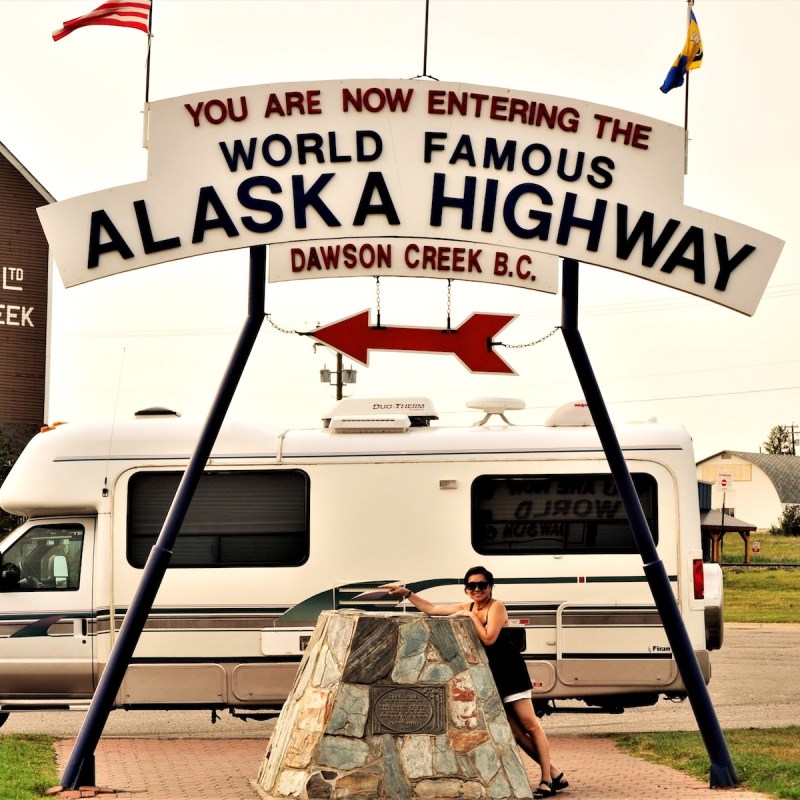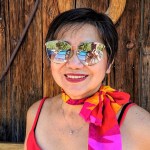
One of the very first items my husband wanted to cross off his bucket list after we bought our first RV (a used 26-foot Class B Telstar by Firan) was to drive the Alaska Highway. When we finished showing off our vehicle to our children in Seattle, Boise, Denver, and Calgary, we were excited to drive to the one in Anchorage. Banff and Jasper national parks, two of four UNESCO World Heritage Sites in the Canadian Rockies, were right on the way, so we briefly explored them. And, after Jasper, we braced for the rugged trip, what my husband promised would be my first epic road trip in an RV.
Videos by TravelAwaits

1. Make Her Part Of The Family
By this time, I had begun calling our new moving mansion “Star.” She took us through the winding roads of northern British Columbia which gave me my first close encounters with North American wildlife I had never seen before except in zoos. A herd of bison lay peacefully by the roadside, but one of them decided to walk towards Star. I huddled inside, and that’s where I stayed because soon a mother and a baby bear showed up among the grass and wildflowers. It was good the big moose hiding in the shrubs was at a distance. Following a small arrow sign, we stumbled upon a multitude of birds and insects by a river. I finally found the nerve to step outside Star!
When we reached Dawson Creek, British Columbia, we could not contain our excitement. The small town of about 13,000 is Mile 0 of the Alaska Highway! Her bragging rights were all over. I asked my husband to take my picture at the signs declaring the official start of the Alaska Highway and I wanted to mark the huge milestone with Star.
Pro Tip: My husband made sure Star was fully prepped for the trip. His checklist included tires, generator, batteries, oil, roof, grey and black water tanks, etc. My job was to make sure the kitchen was fully stocked for a week.

2. Familiarize Yourselves With The Road
The next town was 5 hours away at Mile 300. Even smaller than Dawson Creek, Fort Nelson, British Columbia, the administrative center of the Northern Rockies Regional Municipality, had a population of about 3,500. It hosts the Fort Nelson Heritage Museum, which explained how the Alaska Highway actually began there, how the U.S. and Canada cooperated in the building, and how they divide the maintenance today. The 1,422 mile-long highway has connected Alaska to the lower 48, was militarily strategic in WWII, and is economically important now.
Pro Tip: We were warned that there were not going to be mileposts for the first 1,000 kilometers, crossing the British Columbia/Yukon border several times before reaching the first big town of the pristine and primitive province of the Yukon.

3. Learn About Services And A Few Tricks
On the way, we stumbled upon “a highway service community,” those small villages that support the travelers on the highway. Toad River consisted only of a gas station, a restaurant, and a country store. It was a place to enjoy local fare and to fill up Star. A section of the store was dedicated to thousands of hats, and my sentimental husband didn’t hesitate to leave what he had on.
About a hundred miles north, we saw another arrow we could follow! It led us to the Whirlpool Canyon with a river that made a powerful swirl as it wound its way around a bend. A Canadian couple who were making their way to fish in Nunavut past the Arctic Circle taught us about not being shy to dump gray water (from washing dishes and showering) almost anywhere, and that we could drink creek water if necessary — as long as we were sure there was no beaver contamination.
Pro Tip: Before reaching The Yukon, you will encounter The Summit, the highest point on the Alaska Highway, at 4,250 feet. The area is called the Serengeti of North America, hosting the lovely Stone Mountain, Muncho Lake, and Liard River Hot Springs Provincial Parks.

4. Give Yourselves Rest And Fun
Watson Lake, Yukon was an even smaller town of about 800 at Mile 635, and we loved the good night’s rest at the Downtown RV Park. The next day we thoroughly enjoyed being the 67,000th visitor to place a sign (there are over 80,000 now) at the unique Signpost Forest. We bought a wooden board at a Home Builders’ Centre in town and got the free paint from the Visitor’s Information Centre. That’s also where we registered as Yukon Gold Passport holders which will give us the 5, 10, or 20 troy ounces of gold if we collected 10, 20, or 30 stamps of tourist spots.
Along the highway between Watson Lake and Whitehorse were rocky embankments (between Upper Liard and Rancheria) that are being used to arrange rocks into letters memorializing passersby. We originally thought we could spell out our names, but we found out how difficult the endeavor was and ended up with just the two letters of our first names: BC. On the way back to the mainland U.S., the letters were still there!
Pro Tip: You may want to pass on going to the Northern Lights Center in Watson Lake. Even with displays about the aurora borealis, it was really a brief video of the lights recreated on the dome ceiling for effect that is not worth the time or money.

5. Give Her A Good Mid-Point Check
At Mile 918, we reached Whitehorse, the biggest city in the Yukon with a population of about 25,000. Many places, including the biggest fish ladder in the world, were already closed for the season. But our main purpose here was to give Star a thorough mid-point check-up for the shorter but harder second half of Alaska Highway.
We were fascinated at finding the largest weather vane in the world according to the Guinness Book of World Records: a DC3 plane! Smith House at LePage Park gave us two souvenir Whitehorse pins. And we got to chance to climb aboard one of the only remaining steamboats that transported precious metals on the Yukon River at the SS Klondike National Historic Site.
Pro Tip: This is the only place on the highway where you can dine at a branch of Tim Horton’s, Canada’s favorite coffee chain. Get a bowl of chili!

6. Go Slow For Two Reasons
From Whitehorse, smoke from 50 fires around the Yukon (since it had been so hot and dry that summer) obscured all the beautiful scenery. We could hardly see anything beyond Star’s nose! In fact, Burwash Landing (population just over 70), including most of its wildlife displays and artifacts, was almost wiped out by a huge forest fire caused by humans camping (although lightning is the more common cause).
Another unfortunate thing is the road damage caused by permafrost effects, especially after Destruction Bay. There were many road fissures and small ponds on the fields along its sides. The highway had a roller coaster feel to it, and evergreens in nearby fields could not grow any taller than a few feet. Orange flags were everywhere, designating permafrost damaged areas. The cost of maintaining these roads must be high, and they exacted a toll on Star.
Pro Tip: You will come across White River, so named because of its off-white color due to volcanic ash from two pyroclastic eruptions of Mount Churchill in the Wrangell Mountain Range in 1890 and 1950. Alas, the ecology could not be restored; the river can no longer be used for boating.

7. Don’t Succumb To “Get-There-Itis”
We finally reached the Yukon’s Haines Junction at Mile 1016, but it was not what we expected. We were supposed to be able to get a glimpse of the Juneau glaciers and the highest mountain peak in Canada. We couldn’t because of all the smoke. We decided to stop for the day at the Kluane RV Park.
The village, with a population of a little over 600, is east of the Kluane National Park and Reserve. We looked for a good hiking trail. We thought we did but we had to quickly go back to Star after finding the mosquitoes were so big and hungry. But it was good we found a quaint Quonset hut that also served as a church for as many as 30 people. There we hoped for a clearer tomorrow.
The next day was clearer and we resumed our trek. We passed Mile 1202 at Beaver Creek, Yukon with a small population of almost a hundred. Then we reached Delta Junction, Alaska, with a population of almost a thousand, the official end of the Alaska Highway. The sign at the Visitor Center said it all. From Mile 0 in Dawson Creek to Mile 1422 in Delta Junction, we completed the Alaska Highway in 7 days. It was the rugged one-of-a-kind trip my husband promised, the unforgettable epic first RV experience of this former “desk jockey.”
Pro Tip: Constructed at a total cost of $115 million in about 9 months, at its peak the project utilized 7 Army regiments and 77 contractors with 15,000 employees and 11,000 pieces of road-building equipment. Two teams, one from Dawson Creek and another from Delta Junction, completed the highway when they met at Soldiers’ Summit at the Kluane Lake in the Yukon in November 1942.
For more on traveling by RV, explore these articles:


